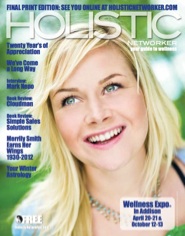How Food Additives Slip Into Your Diet and What To Do About It: Part II
In Part 1 of this two-part series, Allie discussed different categories of food additives and in particular, a controversial group of MSG-containing additives. In Part 2, she discusses how these additives made their way into top-selling organic products, onto the shelves at health food stores, into your kitchen, and what you can do about it.
A Moving Target
Let’s say you’re a person who is not fond of purposely digesting toxic chemicals and commonly known allergens, even in minute doses. Does simply shopping at a health food store offer sufficient protection?
While grocery shopping can you simply scan the label and look for the names of offending ingredients? Yes, but have your mobile Web capability in hand, because you’ll need it to research the ingredients on even seemingly harmless products before you get to the checkout counter. And that brings us back to our chief suspect of the conversation: MSG.
It should be easy enough to avoid. If you know you can not or choose not to consume MSG, why would scanning product labels not protect you? Because while MSG must be included in ingredient lists, MSG-containing ingredients masquerade under different names; but they are most certainly added for the same reason—as a flavor enhancer. Further, many people sensitive to MSG experience similar side-effects from MSG-containing food additives, even if the levels and impact are far lower.
Commonly used MSG-including ingredients are*:
- Hydrolyzed (Vegetable or Plant) Protein
- Plant Protein Extract
- Sodium (or Calcium) Caseinate
- Textured Protein (Including TVP)
- Yeast Extract or Autolyzed Yeast
While many people never note any side-effect whatsoever from MSG or MSG-containing ingredients, some of the most common side effects attributed to MSG consumption include: dizziness, tightness in the chest, tingling sensation in the neck, limbs, abdominal pain, nervousness, and in the extreme, brain damage and damage to nervous system*
Don’t Make Assumptions When Shopping
For the purpose of discussion, let’s say you want to make chicken soup tonight and rather than homemake your broth, you plan to buy it.
Any broth containing monosodium glutamate in the ingredient list is out for you; but you aren’t concerned anyway because the health food store where you shop won’t carry products with MSG. So you stroll in and grab the first carton you see, only later to find out that your soup tasted different that evening because your broth contained a “natural flavor enhancer”: autolyzed yeast extract.
That very thing happened to me. Noting the distinct change in the flavor of my old soup recipe, I returned to the broth carton and read the ingredients. The next day I returned to the Whole Foods Market®, and the manager (helpful and genuinely concerned about my inquiry) said he was unaware that autolyzed yeast extract was a flavor enhancer that contained MSG. And he said, “Wow, and that’s a great seller for us, too.”
I then called the corporate office in Austin, TX to inquire about the decision to carry an MSG-containing product and was referred to an article on their website:http://blog.wholefoodsmarket.com/2008/07/myths-and-misconceptions-msg/
The article explains that while the store will not carry products with the artificial ingredient MSG, it will carry products with the “completely natural ingredients” that contain MSG, such as autolyzed yeast extract. That helps to have clarification; but they have their understanding of completely natural (certainly within the legal boundaries of what is considered “natural”), and we have ours; and they have their reasons for their definition, and we have ours.
I will continue to shop at that store as it remains one of my favorites for variety and quality of nutritious foods, but I now scan each and every label.
Don’t Make Assumptions When Reading
So how does a Pacific Foods Organic product containing autolyzed yeast extract end up a best seller, even while sitting next to the Whole Foods 365 Organic brand of chicken broth that does not? Several ways.
First, to a palate accustomed to chemical additives and “flavor enhancers”, products may taste better with flavor enhancers.
Second, the company advertises the product, and the general public thinks, “Gee, it’s organic, there couldn’t be anything to question in the ingredients.” Understandably.
I contacted Pacific Foods’ headquarters and spoke with a polite representative. I asked why they chose to include a flavor enhancer containing MSG in their organic products. She replied that the company received this inquiry frequently, was aware that some people may have sensitivities to those products, and they recommend that those people don’t consume them. Sage advice.
So then what?
If one must be on-guard even while buying organic products in health food stores, how do health conscious shoppers protect themselves without quitting their jobs and becoming researchers in the field of nutrition? The simplest way is to…keep it simple.
- If you’re in a fast food restaurant, and even if you order salad, know that almost without exception you are choosing to consume food additives, natural and artificial. If you want to avoid food additives, avoid fast-food joints.
- At any other restaurant, do not count on the staff or even the chef to know, but you can ask if they add MSG to their food. Assume that almost all soups are prepared with broth that contains flavor enhancers. Soups and sauces will normally be the biggest culprits in restaurants.
- When shopping, if you find a product with a questionable or unknown ingredient, research it or skip it.
The Great News
There are plenty of wonderful, genuinely whole foods and lightly processed foods to choose from that keep the taste buds and the rest of the body happy!
*Excitotoxins: The Taste That Kills by Russell L. Blaylock
For all articles by Allie, visit:
http://holisticnet.wpengine.com/wp/author/allie/
 Allie Chee is a Certified Chinese Medicine Nutritionist and can be contacted at: question@askalliechee.com
Allie Chee is a Certified Chinese Medicine Nutritionist and can be contacted at: question@askalliechee.com
About Allie Chee
Allie is a certified TCM Nutritionist and author of New Mother: Using a Doula, Midwife, Postpartum Doula, Maid, Cook, or Nanny to Support Healing, Bonding, and Growth










